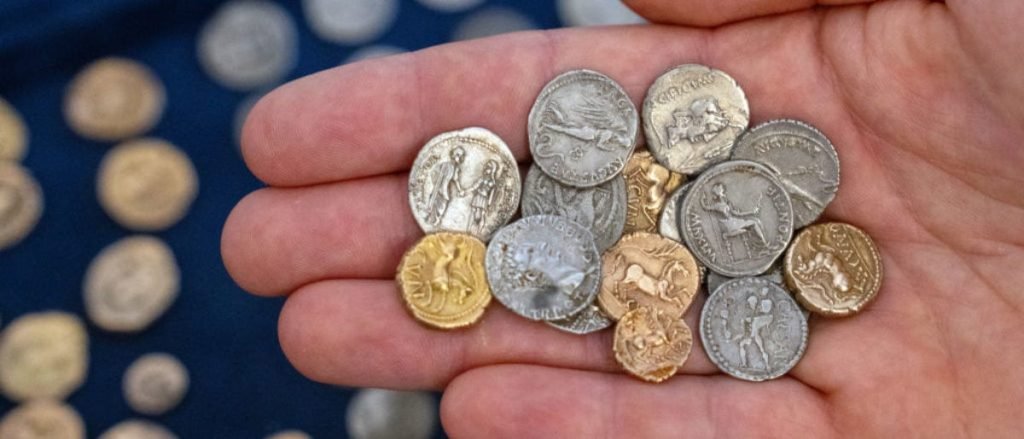Indiana Jones fan George Ridgway discovered a trove of hundreds of historic coins that were ultimately valued at more than $176,000.
According to a Facebook post from Noonan's Auctions, the 34-year-old and his longtime girlfriend, Ruby, who is a qualified archaeologist, were celebrating the historic find.
“I began my history hunt at age four, inspired by my childhood hero Indiana Jones, and dreamed of finding Roman treasure ever since my grandmother bought me a metal detector for my 12th birthday,” says Ridgway. “It was an awe-inspiring moment when I realised I had actually found it!”
The treasure was discovered at Helmingham Hall, near Stowmarket, Suffolk, and was offered for auction at Noonan's Auctions. BBC.
The sale price of the hoarding will be split between the landowner and Mr Ridgway, according to the post.
When asked what he plans to do with his newfound wealth, the Indiana Jones fan replied: “First thing I'm gonna do is buy my dad a beer!”
Ridgway explained how he discovered “an incredible collection of over 680 gold and silver coins dating from 206 BC to the time of Emperor Claudius in 46/47 AD.”
“On September 8th 2019 I decided to use my Garrett AT Pro metal detector to examine some unusual crop marks in a recently harvested barley field in Suffolk. I knew that a Roman road passed close to the field and hoped that the two might be related, but after combing the area I found nothing,” he told Noonan's Auctions.
LONDON, UK – SEPTEMBER 12: A man adjusts a tray of 35 Celtic stater coins found in Kent. The coins, which date back to around 55 BC after Julius Caesar's conquest of Gaul and attempted invasion of Britain, are expected to fetch around £20,000 at an auction later this month on September 12, 2024 in London, UK. Two caches of ancient coins uncovered by metal detectorists in Suffolk and Kent are being auctioned off, raising £75,000 and £20,000 respectively. Such hoarding of wealth is thought to have been a common response to economic and social instability, but today it attracts archaeologists and collectors. (Photo: Carl Cort/Getty Images)
“I found two Roman bronze Colchester brooches dating to the mid-1st century AD 30 yards away. Another clear signal from a nearby detector led me to a silver denarius issued by Julius Caesar in 46 BC. I couldn't believe how after three hours of searching I found more than 160 Roman silver coins, some of which were attached to pottery shards,” he told Noonan's Auctions.
“Convinced I had made an important archaeological discovery, I called my father to guard the site overnight while I waited for the archaeological team to arrive and excavate the site. It took three months to recover the items,” Ridgway continued.
“It was around that time that Iron Age gold coins of Cunobelin, king of the Katuwerauni and Trinovantes, began to appear,” he recalls.
Coin expert Alice Cullen of Noonan's Auctions spoke about the historic find.
“This is one of the largest hoards of both Iron Age and Roman coins ever found in Britain, with the latest coins of Claudius and those of Cunobelin remaining almost as minted,” she said.
Cullen cited two possible scenarios that could explain why the treasure was buried in the place it was.
“The location and date range of the deposit suggest that the coins may have been buried by a long-time legionnaire from the 20th Legion, who was stationed at nearby Colchester,” she added. (RELATED: Kobe Bryant's final warm-up jacket sells for big buck at auction)
“In 47 AD the Iceni people of East Anglia rebelled after receiving orders from the Roman governor Ostorius to disarm, and a fierce battle ensued at Stornea Camp in Cambridgeshire which the Romans appear to have won. Is it possible that casualties of this conflict may have hidden our treasure?” Cullen said.
According to Noonan's Auctions, the British Museum, Colchester Museum and Ipswich Museum have secured 63 of the 748 coins found for addition to their collections.
















